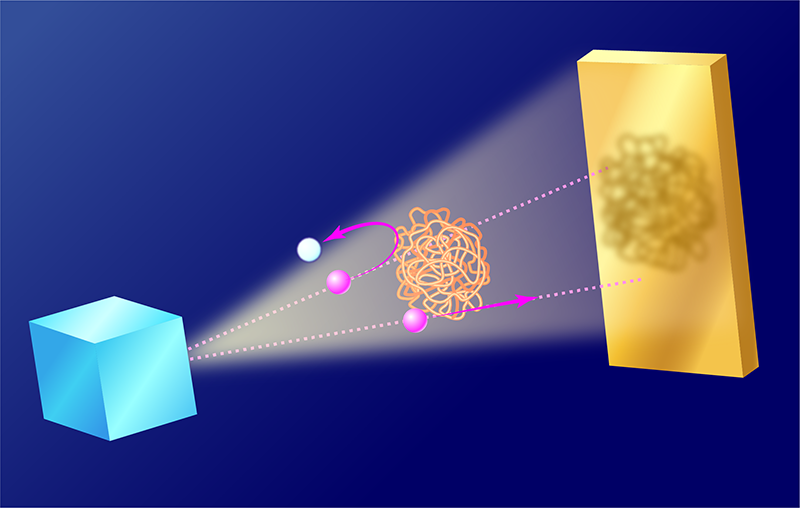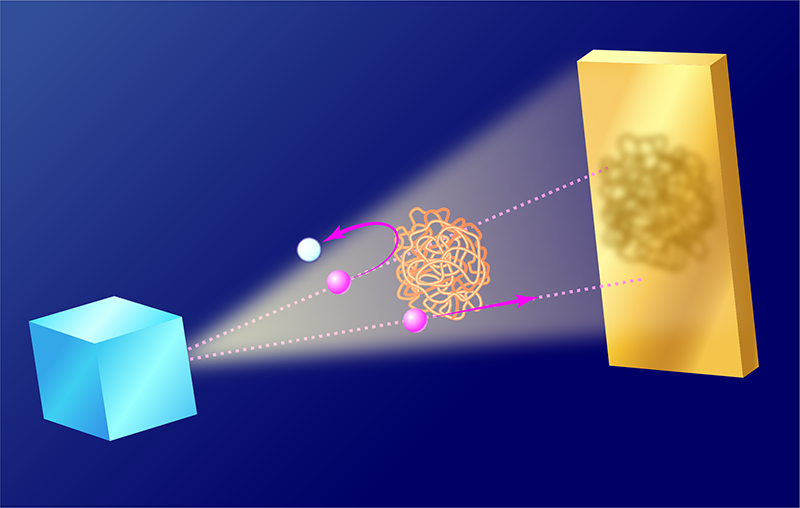Looking Inside the Superfluid Helium-3 Universe
When liquid helium-3 is cooled to millikelvin temperatures, it transitions into a state of matter called a superfluid. From the outside, superfluid helium-3 looks like a simple, transparent medium. Nevertheless, its internal structure is extremely rich and is often described as “the Universe in a droplet” [1]. In helium-3, some atoms collectively play the role of the quantum vacuum—the macroscopic quantum state with the lowest-possible energy—and others behave like matter, interacting through analogs of electromagnetic and gravitational forces. So far, researchers have learned how to “smell” this internal structure by probing the weak magnetic field surrounding the helium-3 nuclei, “touch” it by pushing external objects through the fluid and measuring the reaction force, and “hear” it by placing a speaker and microphone inside the fluid. Now, Theo Noble and colleagues at Lancaster University in the UK have brought in a fourth sense with a camera that can “see” the intrinsic details of the helium-3 universe [2]. This capability could allow researchers to better understand turbulence in quantum fluids and to detect topological structures that are predicted to be hiding in this superfluid world.
In superfluid helium-3, pairs of atoms called Cooper pairs form the vacuum, which exhibits unusual dynamical properties, such as flow without friction. By contrast, unpaired atoms form a type of matter consisting of so-called fermionic quasiparticles. The energy of these quasiparticles cannot be in a specific range, which can differ from place to place in an inhomogeneous system. Consequently, a propagating quasiparticle might be unable to enter some regions of such a system and would instead be reflected through a process called Andreev reflection [3]. In this process, the incoming quasiparticle traps a partner to form a Cooper pair, which becomes part of the vacuum, and the partner leaves behind an excitation known as a hole that propagates in the opposite direction to that of the incoming quasiparticle. The inhomogeneity that causes this reflection can be manufactured, such as in superconducting Josephson junctions—devices that are used in qubits for quantum computers. But it can also be intrinsic, as is the one exploited by Noble and colleagues.
A superfluid that flows rapidly past an obstacle cannot meet the motion constraints of an ideal fluid and deforms locally. Quantum mechanics and topology confine this deformation to a linear structure called a quantized vortex, which exists in superfluid helium-3 as a string with a thickness of less than 100 nm. Superfluid flow around this vortex carries one quantum of circulation. The flow shifts the forbidden energy range for the quasiparticles by an amount that depends on the distance to the vortex. This intrinsic inhomogeneity leads to Andreev reflection of quasiparticles moving next to the vortex.
In the presence of dynamically evolving arrangements of many vortices, a superfluid can mimic various complicated, large-scale flow patterns that are not limited to the frictionless motion of an ideal fluid. An active area of research dubbed quantum turbulence explores how the interaction of simple, identical vortices at microscopic scales leads to complex dynamics at large scales [4]. Noble and colleagues focused on this area for the first demonstration of their camera’s capabilities.
Their apparatus has three parts, which are all completely immersed in a bath of superfluid helium-3. The first part is a quasiparticle source: a closed box inside which a moving mechanical device breaks Cooper pairs into quasiparticles that leak through a pinhole. Outside the box, the temperature is much lower than the superfluid transition temperature of helium-3, and few Cooper pairs are broken up by thermal fluctuations, so the quasiparticles fly from the hole as straight as light rays. The second part is a vortex source: an oscillating semicircular wire loop that generates vortices when the flow velocity around the loop’s surface reaches a critical value. Finally, the third part is the camera: a five-by-five array of quartz tuning forks. The damping of the oscillation of each fork is proportional to the number of nearby quasiparticles, which is translated into the brightness of the corresponding pixel on the image taken by the camera.
Before turning on the vortex generator, Noble and colleagues showed that the image produced by the quasiparticles is precisely described by illumination laws established for light. After turning on the generator, they found that vortices block some quasiparticles from reaching the camera because of scattering by Andreev reflection (Fig. 1), creating a shadow of the vortex tangle in the image taken by the camera. Unexpectedly, the authors discovered that the outer edge of the wire loop produces many more vortices than the inner edge, even though the flow velocities should be nearly the same on both edges. This effect is still unexplained, but it demonstrates how the camera provides new insight into the superfluid helium-3 universe.
Visualization of flows has proven essential for understanding classical turbulence, and there is an ongoing effort to achieve a high level of detail in experiments on quantum turbulence. The usual approach to visualization is to follow the motion of small tracer particles added to the fluid, but suitable tracers are difficult to find and to image near zero temperature. Noble and colleagues’ technique works without tracers and is also remarkably noninvasive because Andreev reflection applies almost no force to the imaged object. Future cameras could contain a larger array of pixels thanks to nanofabrication technology and might operate more quickly, which would enable the transition from still images to video recordings.
These cameras could look, for example, at the dynamics of vortices in superfluid helium-3 near a rough boundary. Such observations might help to clarify the link between sudden accelerations in the rotation of a neutron star and the pinning of quantized vortices—which pierce the star’s superfluid interior—to the star’s crust [5]. The helium-3 vacuum has a nontrivial topology, which means that its boundaries host zero-energy quasiparticles, such as Majorana modes [1, 6], and the cameras could be used to study the interaction of these surface states with bulk quasiparticles or with moving vortices. The cameras might also image topological objects shaped like lines, sheets, or balls, which are thought to form in the helium-3 vacuum in superfluid phase transitions resembling those that occurred in the early Universe. Finally, when used without a quasiparticle source, the cameras could look for the breakup of Cooper pairs by incoming cosmic rays or even by proposed dark matter particles [7].
References
- G. E. Volovik, The Universe in a Helium Droplet (Oxford University Press, Oxford, 2009)[Amazon][WorldCat].
- M. T. Noble et al., “Producing and imaging quantum turbulence via pair-breaking in superfluid 3He−B,” Phys. Rev. B 105, 174515 (2022).
- A. F. Andreev, “The thermal conductivity of the intermediate state in superconductors,” Sov. Phys. JETP 19, 1228 (1964).
- L. Skrbek et al., “Phenomenology of quantum turbulence in superfluid helium,” Proc. Natl. Acad. Sci. USA 118, e2018406118 (2021).
- N. Andersson, “A superfluid perspective on neutron star dynamics,” Universe 7, 17 (2021).
- T. Mizushima et al., “Symmetry-Protected Topological Superfluids and Superconductors —From the Basics to 3He—,” J. Phys. Soc. Jpn. 85, 022001 (2016).
- UK Research and Innovation, STFC grant proposal, Quantum enhanced superfluid technologies for dark matter and cosmology.





